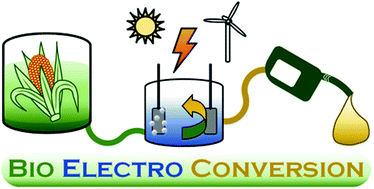Production of drop-in fuels from biomass at high selectivity by combined microbial and electrochemical conversion†
Abstract
Renewable electrical energy production, such as wind power or photovoltaics, faces temporal fluctuations and spatial separation of source and sink creating the need for suitable storage and conversion technologies. Furthermore, a bio-based economy needs technologies allowing the on-demand and on-site conversion of biomass to platform chemicals and chemical energy carriers. This study combines microbial and electrochemical conversions, allowing production of chemicals from biomass and electricity. Carboxylic acids (CAs) are produced by anaerobic conversion of a renewable feedstock with reactor microbiomes. CAs are subsequently electrochemically upgraded to yield energy-dense alkanes. We present a proof-of-concept based on experimental data for each step in two independent case studies at laboratory scale. During continuous CA fermentation from corn beer, mainly n-caproic and n-caprylic acid were produced yielding in total 0.638 g COD g−1 COD [CA/corn beer]. A batch system fed with corn silage yielded mainly n-butyric acid (0.207 g COD g−1 COD [CA/corn silage]), and some n-caproic acid (0.030 g COD g−1 COD [CA/corn silage]). The CAs were removed from the fermentation broth using a pertraction system. Subsequently, the CAs were electrochemically converted via Kolbe reaction and other reaction pathways. Depending on the carbon chain length of the CAs, liquid alkanes (from medium-chain CAs) or gaseous alkanes and alcohols (from short-chain CAs) were gained. Coulombic efficiencies of up to 80% were achieved despite the alkaline (pH 9) electrolysis conditions that are dictated by the pertraction system. Remarkably, CAs with a carbon chain length of six or more C-atoms were successfully converted to liquid alkanes at a high yield (in total: 0.480 g COD g−1 COD [hydrocarbon/corn beer]). This was achieved at an energy input of only 0.100 kW h per mol of converted CA (considering the electrochemical half cell reaction). Noteworthily, the electrochemical CA conversion is much faster than the CA fermentation, allowing intermittent electrolysis during periods of excess electrical power. We demonstrate that the finally gained product is suitable as a drop-in fuel without any further downstream processing. The future general potential as well as requirements for the concept are discussed.



 Please wait while we load your content...
Please wait while we load your content...